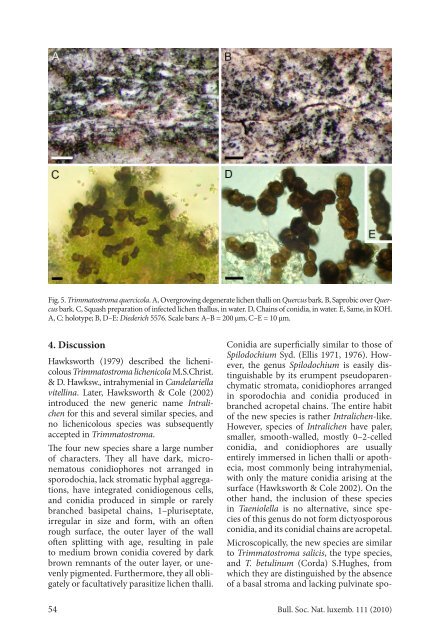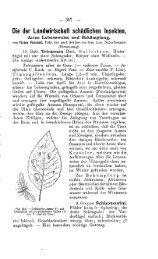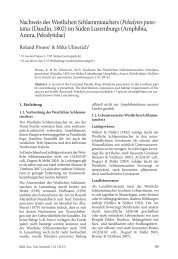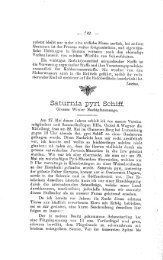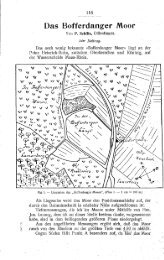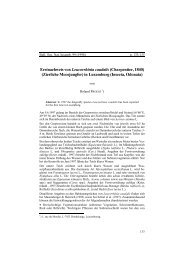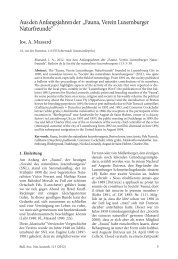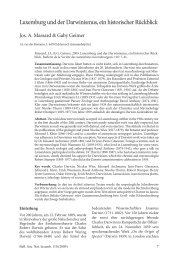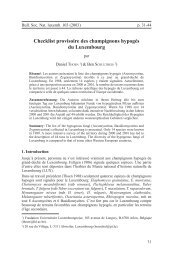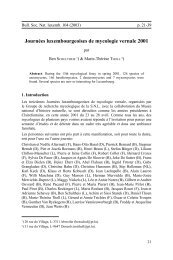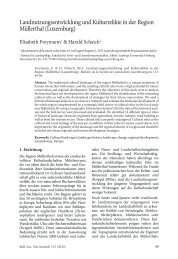Four new lichen-associated Trimmatostromaspecies ... - SNL
Four new lichen-associated Trimmatostromaspecies ... - SNL
Four new lichen-associated Trimmatostromaspecies ... - SNL
Create successful ePaper yourself
Turn your PDF publications into a flip-book with our unique Google optimized e-Paper software.
Fig. 5. Trimmatostroma quercicola. A, Overgrowing degenerate <strong>lichen</strong> thalli on Quercus bark. B, Saprobic over Quercus<br />
bark. C, Squash preparation of infected <strong>lichen</strong> thallus, in water. D, Chains of conidia, in water. E, Same, in KOH.<br />
A, C: holotype; B, D–E: Diederich 5576. Scale bars: A–B = 200 μm, C–E = 10 μm.<br />
4. Discussion<br />
Hawksworth (1979) described the <strong>lichen</strong>icolous<br />
Trimmatostroma <strong>lichen</strong>icola M.S.Christ.<br />
& D. Hawksw., intrahymenial in Candelariella<br />
vitellina. Later, Hawksworth & Cole (2002)<br />
introduced the <strong>new</strong> generic name Intra<strong>lichen</strong><br />
for this and several similar species, and<br />
no <strong>lichen</strong>icolous species was subsequently<br />
accepted in Trimmatostroma.<br />
The four <strong>new</strong> species share a large number<br />
of characters. They all have dark, micronematous<br />
conidiophores not arranged in<br />
sporodochia, lack stromatic hyphal aggregations,<br />
have integrated conidiogenous cells,<br />
and conidia produced in simple or rarely<br />
branched basipetal chains, 1–pluriseptate,<br />
irregular in size and form, with an often<br />
rough surface, the outer layer of the wall<br />
often splitting with age, resulting in pale<br />
to medium brown conidia covered by dark<br />
brown remnants of the outer layer, or unevenly<br />
pigmented. Furthermore, they all obligately<br />
or facultatively parasitize <strong>lichen</strong> thalli.<br />
Conidia are superficially similar to those of<br />
Spilodochium Syd. (Ellis 1971, 1976). However,<br />
the genus Spilodochium is easily distinguishable<br />
by its erumpent pseudoparenchymatic<br />
stromata, conidiophores arranged<br />
in sporodochia and conidia produced in<br />
branched acropetal chains. The entire habit<br />
of the <strong>new</strong> species is rather Intra<strong>lichen</strong>-like.<br />
However, species of Intra<strong>lichen</strong> have paler,<br />
smaller, smooth-walled, mostly 0–2-celled<br />
conidia, and conidiophores are usually<br />
entirely immersed in <strong>lichen</strong> thalli or apothecia,<br />
most commonly being intrahymenial,<br />
with only the mature conidia arising at the<br />
surface (Hawksworth & Cole 2002). On the<br />
other hand, the inclusion of these species<br />
in Taeniolella is no alternative, since species<br />
of this genus do not form dictyosporous<br />
conidia, and its conidial chains are acropetal.<br />
Microscopically, the <strong>new</strong> species are similar<br />
to Trimmatostroma salicis, the type species,<br />
and T. betulinum (Corda) S.Hughes, from<br />
which they are distinguished by the absence<br />
of a basal stroma and lacking pulvinate spo-<br />
54 Bull. Soc. Nat. luxemb. 111 (2010)


